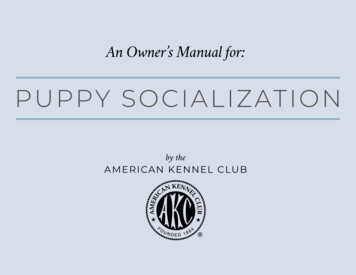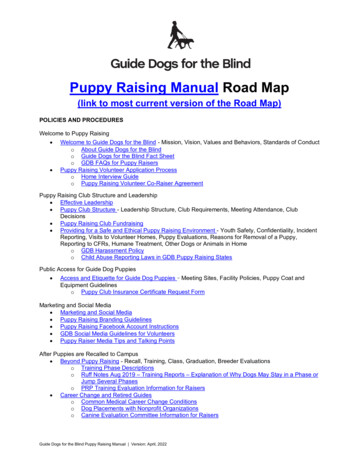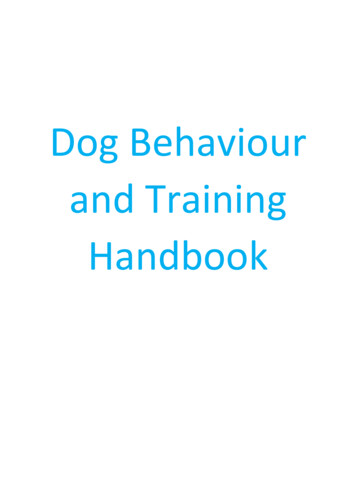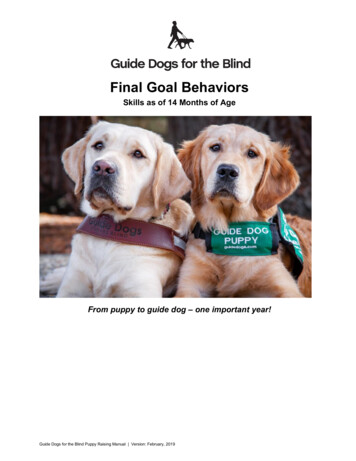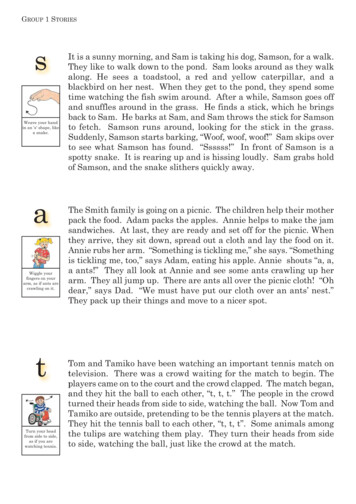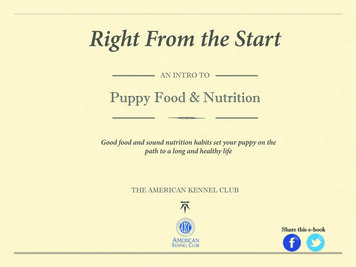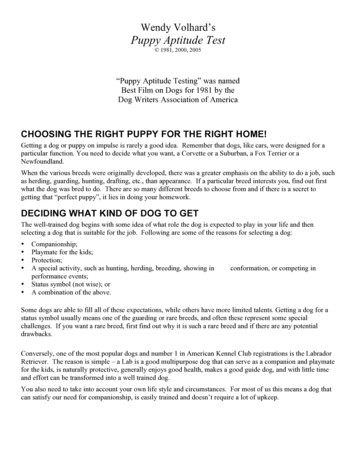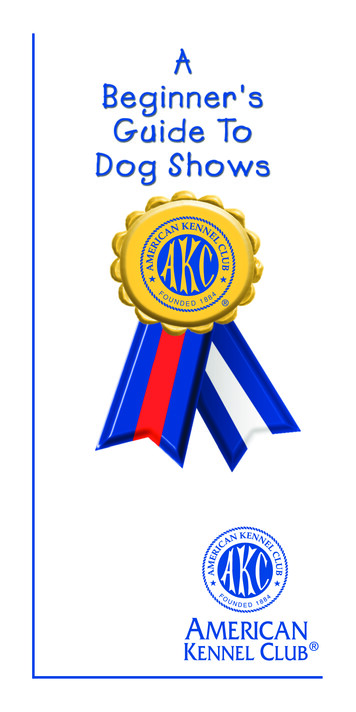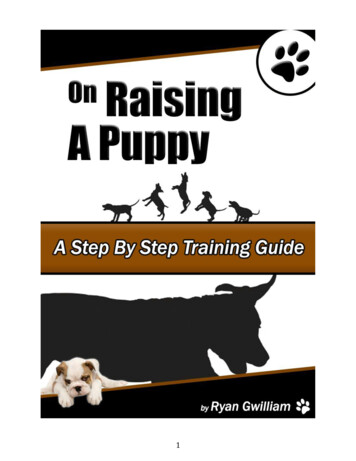
Transcription
1
IntroductionWelcome to my puppy training guide. Chances are yourpuppy has some bad habits (as all puppies do) which hasled you to Train Walk Poop. First let me say, I feel your pain.Raising a puppy is one of the most adorably, frustratingthings you will ever do!Finding the balance between meeting your puppy’s needsand meeting your own day to day obligations is no simpletask. I hope this training guide will give you a sense of reliefand a feeling of excitement about raising your puppy.Ryan Gwilliam and PigFounders of Train Walk Poop2
The 1, 2, 3s of Puppy TrainingYou can follow these three simple steps to solve many puppy behavioral problems:1. Bark2. Bump3. BoundaryBark – this is simply a verbal correction by you. A firm “no”, a snap of the fingers,or a clap will do the trick. The point is to mark exactly where the dog makes amistake audibly.Bump – if your verbal correction is ignored do not repeat yourself. Instead followup with a physical correction. It should be a simple bump of the knee (if he’s tallenough) or a poke with your fingers (Cesar Millan style). The purpose is to get yourdog’s attention; if your dog looks at you when you do this you’re probably doing itright. Timing is everything here as well; if you do it too early or too late he will beconfused as to why you bumped him. This should be a gentle redirection of yourpuppy’s focus.Boundary – this is basically a doggy timeout without doors or gates to block him(very important that your dog stay behind his boundary line because you areasking him to stay and not because he is forced to). Here’s a video that shows youhow to apply all 3 steps:Teach Your Puppy to Take Treats Nicely & Respect Boundaries 2 of 2The above video is part two, I highly recommend you watch part one now, so youcan learn how we got this hyper puppy interested in playing this game with us inthe first place. If you go straight to bumping your puppy out of the room (like invideo part 2 which you just watched), you will likely fail and you’ll both end upfrustrated. Here’s video part 1:Teach Your Puppy to Take Treats Nicely & Respect Boundaries 1 of 2STOP! Try playing the game in part one with your puppy now. Once you’ve done atraining session (keep it under 10 minutes for puppies) then come back andcontinue learning.3
Timing and ConsistencyThe importance of timing and consistency cannot be stressed enough. Your dog willbe beyond confused if you don’t time your corrections right. He will be equallyfrustrated if you aren’t consistently correcting unwanted behaviors.Timing Ex:Your puppy grabs some food off the coffee table, and you show up a few secondslater and yell “no”! This would be BAD timing. He already got a huge reward beforeyour verbal correction so you can expect him to do it again. If you would havecorrected him right as he was thinking about grabbing that food however he wouldhave left it alone and you are headed in the right direction (if your dog ignores yourbark what do you do? Go to step 2 and give him a bump)Consistency Ex:Your puppy jumps on you. Depending on your mood or because you just got homeyou reward it because it’s soooo cute. Other times it annoys you and you try todiscourage it; your poor puppy is so confused. He’s probably wondering, “why can’tmom make up her mind already?”It’s mean to confuse your puppy like this, so be consistent with house rules. If youdon’t want your puppy to jump then draw that line in the sand and never rewardthe behavior. If you are never rewarding jumping and your puppy is still doing itwhat do you do? Follow the 1, 2, 3s of dog training of course! Be consistent andwatch how quickly your puppy can learn.4
Potty TrainingEnjoy this free chapter from my dog training ebook, “From Puppy to Pack Leader”.When a mother gives birth to a litter of pups she keeps the den very clean. She willeat the pup’s waste during the first few weeks of life.For a young puppy to suddenly end up in your house, or even more confusing inyour apartment, and be expected to “hold it” for any period of time is justunrealistic. Here is how to potty train a dog in as little time as possible:The following will work for adults and for puppies.Adults are generally much easier even though they’ve had the “bad habit” for solong because they usually know what we are looking for already and havedeveloped the necessary bladder control muscles. If your dog is over 4 months oldand still having regular accidents in the house it is most likely due to frustration orsimply not caring where you want her to go.You may be thinking, “yeah right! I’ve yelled at her so many times for going to thebathroom in the house. There is no way she doesn’t know what I want.”Ask yourself the following:1. Is your dog over 4 months of age?2. Have you caught your dog in the act of going to the bathroom in your house 10times in a row?3. When you caught your dog in the act did you immediately go outside and waituntil the dog finished going potty outside?These questions are important because unless you are consistent, your timing isperfect and the dog knows that going potty near you is not always a bad thing,chances are your dog is just plain confused.Keep in mind that 95% of the time potty training problems in dogs over 4 monthsold quickly dissipate on their own when the rest of the principles found in this bookare adhered to. Dogs who are getting regular exercise and who know their place intheir family rarely leave steamy piles of poo on their owner’s floor.5
When you catch a dog in the act all you need to do is startle him.Interrupt the behavior by clapping your hands or saying “NO” in a firm tone as youwalk toward your dog. Once the peeing or pooping has been interrupted you nowact like your dog’s best friend again. Calmly walk your dog toward the door and gooutside with him so he can finish relieving himself in the proper area. When hedoes, praise him!Timing is key. Be as consistent as possible. The better your consistency thefaster your dog will learn.The number one commandment of potty training is, “Thou shalt interrupt thebehavior 100% of the time, at exactly the same time, or thou shalt wake up to a freshsteamer all the days of thy life.”Take your dog to the same exact spot every time and don’t carry him if at allpossible. It’s important that he walks and smells the path to his spot several times aday.The second he finishes outside pet him and praise him. No need to jump up anddown and get your dog all riled up, but let him know you are proud of him. Treatscan be used as well, but are generally not needed since relieving oneself feels goodand is self rewarding. Also if he smells the treat before he pees he may get sodistracted by it that he will forget to pee so beware.Again, if your pup has a routine everyday his internal clock can adjust to it. Makeyour dog’s schedule as predictable as possible for him and it will pay off individends.One last resort for older dogs and puppies who are very accepting of being leashedis to tie your puppy’s leash around your waist for the first week or so. This way youare guaranteed to be there every time he makes a mistake. This works especiallywell for people who are easily distracted, and for owners of little dogs (they can beespecially sneaky).As a side note, DON’T USE PUPPY PADS! Puppy pads are extremely confusing todogs. You are basically training your dog to pee in the house so don’t mess withpads unless it is out of necessity (like if you live on the 15th floor of an apartmentbuilding, and the only grass is several blocks away).6
Be aware that when you move to a new home or visit other people’s homes it willfeel natural for some dogs to pee in this new territory. Keep an extra close watch onyour dog in these new situations to prevent this nasty habit from developing.Whenever I go someplace new with my dog I take her out to potty about 10minutes after arrival (even if she just peed or pooped), a high percentage of thetime she will go again.Not All Dogs Pee On Your Floor For The Same ReasonLastly, not all peeing/pooping in the house is potty training related. I know you’rethinking, “wait. what? That makes no sense.”Trust me, a dog will pee in your house to be territorial, out of frustration,excitement and anxiety. None of which have anything to do with knowing wherethe humans want the dog to pee.Most older dogs know exactly where you want them to go, but they either don’tcare, or they can’t control their pee even though they want to (see your vet if youthink this may be contributing to your dog’s problem).If the methods described above aren’t improving results noticeably within 2 weeks,you are either doing it wrong or your dog may have a health issue your vet needs toaddress. If it isn’t health related it’s time to call a reputable dog trainer in your area.Bonus Potty Training Tip: For young puppies potty training is stressful becausemany times they try to ask us to let them out but we don’t notice. For example: myfirst puppy would come and give me a look that I thought meant he wanted to bepet. So I’d pet him and he’d pee on the floor moments later.The solution? Train your puppy to ring a bell to let you know when he needs to getoutside! Here is my step by step video that will show you how to get your pupringing the bell every time:Teach Your Puppy to Ring a Bell for Potty TrainingNote: if you’d like to read my full dog training ebook, “From Puppy to Pack Leader”you can purchase it here for 5.95 and download it immediately.7
MouthingAs I’m sure you are aware, puppies want to eat everything. This includes yourhands, clothes, furniture and anything expensive. I recommend you say “no” in afirm, stern voice and then redirect with a toy or a treat. We don’t want to do this foryour dog’s entire life, but for the first few months of life, and during the initialpuppy training sessions this is the best approach.When your puppy is mouthing or biting a lot always remember to redirect, redirect,redirect! For a real life example watch this video:Quick Tip: Puppy Biting HandsI know this seems too simple an answer, but that’s all there is to it; your puppy willsimply need to grow out of this stage of her life. Until she does, the best way to keepyour sanity is to redirect your pup’s mouth to puppy approved items and makesure to meet her energy needs (puppy proofing your home can save you a lot oftime, energy and money too; get non-puppy approved items off the floor). Themore bored your puppy is throughout the day, the more she will take that boredomout on your arms, legs, furniture and kid’s toys.Side note: sometimes a puppy’s mouthing behavior will improve temporarily andthen regress when their puppy teeth start falling out. Much like a teething baby, ateething puppy can be a bit more moody and mouthy for a couple weeks.8
How to Introducing AnythingYour Puppy FearsA common problem is that certain things scare puppies because they are loud(vacuums, construction equipment, blow dryers), or they move in weird ways(skateboards, bikes, strollers). Here’s the step by step process to introduce thingsto your puppy in a fun way:How to Introduce Anything Your Puppy Fears9
Pulling on the leashHow do you get your puppy to stop pulling and biting on the leash? There are 2different correct answers to this question depending on how old your dog is. Isyour puppy younger than 3 months? If yes, continue reading; if no, skip to the nextsection about leash pulling.For Puppies 7–12 Weeks OldThink about it from your puppy’s perspective, how much would you hate leashes ifyou were a puppy? The leash puts pressure on your neck and stops you from goingwhere you want to go. Why wouldn’t you try to bite it off? You would at least pullhard in hopes that you can reach that stick or leaf that is just beyond reach.And guess what, your puppy is too young to be leash trained. So stop trying to getyour puppy to heel; it ain’t gonna happen!Here’s how I recommend you walk a 10 week old puppy:How to Walk a Puppy Under 3 Months OldIf you’re learning from my videos please be sure to click the like button and/orshare them on your facebook page. The more interaction I get from viewers likeyou the more feedback I have for my next video! Plus you could be that friend thatbrings a world of relief to a friend’s life who is struggling with his/her dog’sbehavior.Now you know the truth about teaching a young puppy to heel. Come back to thissection when your puppy is 3 months old and teach your puppy to heel when he ismentally ready to handle it.10
Leash PullingThe following video is an instructional video on how to teach your dog not to pullon the leash. It’s all about communicating with your puppy through leash tension. Ifyou’re doing this right, the results come quickly and last a lifetime:Teaching a Puppy to Heel Using Gentle Leash PressureIt’s very important you teach this with NO distractions. This means nothing on thefloor that might be distracting, no kids running around, no other dogs wanderingaround and no distracting smells. Indoors always works better than outdoors, but areally quiet driveway can also do the trick (grass is too much fun to sniff, so savethe backyard and front yard for another day).The above video should have you well on your way to a well behaved dog while onwalks. If your dog is still struggling I highly recommend you get signed up for oneof my training courses. You can learn about my puppy training course by goinghere: www.trainwalkpoop.com11
Jumping up and demanding attentionHow do I get my dog to stop jumping up? Jumping up is a way for your dog todemand your attention, so before I explain how to put an end to the jumping pleasewatch this video:Is Your Dog Asking or Demanding Attention?Now do you understand the difference between polite requests for your attentionand impolite ones? Great! Now I can explain how to stop the jumping.First, stop rewarding the jumping! If your puppy is still jumping then you must berewarding or at least not discouraging it in the right way. The best way is to followthe 1, 2, 3s of puppy training, so when your puppy jumps you say “no” right as hestarts jumping. Then you bump him in some way to make him get down (don’t betoo rough here, it won’t help. Be gentle yet firm and very patient for fastest results),if he jumps again you’ll send him out of the room or behind some sort of boundaryuntil he settles down (depending on the puppy I may opt for a short “on leash”timeout instead of a timeout behind a boundary).If your puppy decides that Bark, Bump, Boundary is a fun game to play and that allthe negative attention is a lot fun then she likely needs a leash work session oranother puppy to play with to get all those wiggles out.12
Kennel/Crate TrainingIntroducing the crate properly is very important for him to have a positiveexperience. Even if he has already had some unpleasant experiences in his crate,this will start to change the crate to have more positive associations. This one ismuch easier to understand in video format, so without further adu:Crate Training Your Puppy Step By Step InstrucionsCrating your puppy is the safest and best way to encourage good behavior whileunsupervised. Puppies can easily choke on many household items or eat somethingthat will make him sick, so be safe and teach your puppy that the crate is his newhappy place while you are away.This is not a suggestion; crating is mandatory. I’ve had many past clients say,“oh my dog does great in the house without a crate.” Then a year or two later theirdog gets into the flavored pain meds from the vet one day and ends up with kidneyissues for the rest of his life (I hear this exact story at least once a year), or theirdog will eat a chocolate bar or a sock and end up being rushed to the emergencyVet.Don’t be the person who tells me a horror story this year; introduce the crateproperly and use it for life! Every single dog trainer I have ever met crates their dogsfor life; there is a reason for it.Give yourself a break during the day, even while you’re home, by putting yourpuppy in his crate. If you have met his emotional needs by giving him exercise,training and affection then it’s time you reward yourself with a much needed break.How long can my puppy be crated safely? It depends on personality, energy levels,bladder control abilities, etc. Generally if your dog has been well exercised bothmentally and physically then he can be kenneled during the day for several hours. Agood general rule is if your dog is 2 months old then 2 hours is the max time, 3months old then 3 hours would be the max and so on.13
ConclusionI hope you’ve learned a lot from our free training guide. This guide should beenough to improve your puppy’s day to day behavior, but if you want to get to thatnext level and really get your puppy’s behavior under control please give us a callto set up a training session.Visit us at www.TrainWalkPoop.com or shoot us an email toinfo@trainwalkpoop.comIn the end, the most important thing for your success with training your puppy willcome down to consistency. If your behavior towards your puppy is consistent, yourpuppy’s behavior toward you will be consistent.Keep LearningGet signed up for our Social Class. Your puppy will get some play time and gettrained at the same time. Your puppy will need to be assessed by one of ourtrainers before attending, and there is a small fee for the assessment, but onceassessed the class is free for life for your puppy! You can get the details here:http://www.trainwalkpoop.com/social-classTo see my puppy training courses go here:http://www.trainwalkpoop.com/trainingP.S. If you’re in need of a dog walker or pet sitter we’d love to help with that as well.To learn how your puppy will be GPS tracked on each walk, how we will secureyour house key and to meet some of the dog walkers we’ve hired go here:http://www.trainwalkpoop.com/63-2/71-2/14
We also offer daycare and boarding options. Our daycare is managed by ourtrainers, so we monitor social interactions closely. Here are a few of the manythings your pup will learn and do in our daycare group: Healthy play and social skills Basic leash work How to walk on a treadmill Group walks Being calm in the crate Staying in place on command Sitting on command Coming when calledMore info can be obtained on our website:http://www.trainwalkpoop.com15
Bonus Section: Teach Your Dog to Walkon a TreadmillTeaching your puppy to walk on a treadmill can be a great outlet for all that puppyenergy. It teaches your puppy to focus on one thing for an extended period of timeand is perfect for those extremely hot sunny days/extremely cold winter days.Introducing the treadmill is easier to learn through a video, so here you go:Step By Step Treadmill Dog Training16
FAQDo you teach with positive or negative reinforcement training? Short answer is both.Our trainers both reinforce good behaviors and discourage bad behaviors. If you everfeel uncomfortable with our approach (I highly doubt you will), please let us know andwe will approach your dog’s training a different way.Which is better, group or 1 on 1 training? We implement both as needed. Your dog isunique, so the best way to decide which route to take is to Contact Us so we canevaluate your situation and make a suggestion. Both forms of training will be veryhelpful, but depending on your dog it may be best to start with the In Home Course.My dog is fairly well behaved. Can you help me and my dog? Yes. I’m glad you’ve gotthe basics down with your dog. I’d love to help you take your dog’s obedience to thenext level. Whether that means having off leash control of your dog or preparing totake your CGC (Canine Good Citizen) test.How old does my puppy need to be before getting training? It is never too early tostart training your dog. Puppies can be surprisingly well mannered by 3-4 months ofage. Get professional advice now before your puppy develops bad habits that can behard to break.17
Enjoy this free chapter from my dog training ebook, “From Puppy to Pack Leader”. When a mother gives birth to a litter of pups she keeps the den very clean. She will eat the pup’s waste during the first few weeks of life. For a young puppy to
